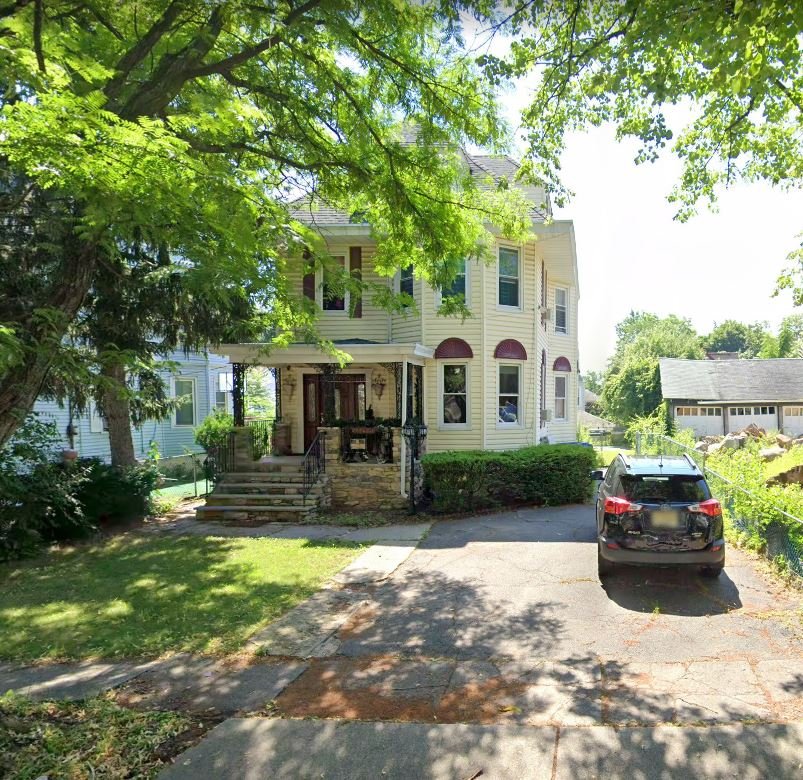
Rutherford Historic Preservation Society
The Streets of Our Town
By: Rod Leith
Historian
The Streets of Our Town
Between the highways there it lies,
this small town before my eyes.
The majestic trees line up the roads,
like old broken soldiers, all in a row.
The old Victorians breaking through the canape,
that line the streets so gallantly.
The church steeples reaching heavenwards,
as the church bells toll with a common stroke.
By the canon an old couple perched on the park bench,
across the street workers dig a trench.
The sunrays bounce off the glassy river waters,
the sound of oars splash the murky waters.
By the roundabout where the streets meet,
crowds off the train station shuffling their feet.
As the day gets swallowed by the night,
the stars above come into sight.
anonymous
Belford Avenue.
(Might have been originally designated as Belford Place).
It was named in honor of the “Bell” family.
Henry Bell was the founder of the “Rutherford Heights Association” (RHA), a home builder responsible for the first houses built in the 1890s on what became “Home Avenue”.
Henry owned a magnificent mansion on property situated at the corner of Prospect and Union. The mansion was sadly demolished. Henry Bell sold the property for a new “Rutherford Congregational Church” after its original church on Carmita/ Washington was destroyed by fire.
John Bell, Henry’s son, was a prominent Rutherford attorney.
(An interesting note on the RHA: It sold the lot to William G. Williams and Raquel (nee Hoheb) for a house built at what became 87 West Passaic Avenue, the birthplace of William Carlos Williams.
Alwyn Terrace
Believed to be named for Alwyn Ball, a prominent New York City real estate agent who settled in Rutherford in the late 19th century. He resided at 208 Montross Avenue. He was a founder in 1892 of Plymouth Brethren Chapel, which later was known as Gospel Chapel, located at 118 Union Avenue in 1922. He had a son, Alwyn Jr., a grandson, Alwyn III, who attended Princeton University in 1914. The Gospel Chapel was relocated to 161 West Passaic Avenue in or about 1928.
Hackett Place
Augustus Peter Hackett was born in Canada on January 8, 1856. His parents were William A. Hackett and Emma Julia Hackett, He was married to Elizabeth C. Heins on April 15, 1877, and is believed to have settled in Rutherford (then Boiling Springs) about 1870. He was a volunteer fireman and a bicycle enthusiast, having become a member of the Wheelmen (Bicycle) Club when it was formed about 1874. He later became president of Engine Company # 3 in what was West End Rutherford. Augustus Hackett is reportedly paid $2,000.00 to have a dirt roadway paved before that road became Hackett Place. He and his family occupied the house at the corner of Union Avenue and Hackett Place. Another important resident of Hackett Place was J. Lewis Chapman who for many years owned a sporting goods store on Union Avenue. Sadly, Lewis Chapman was killed in an auto accident in 1958. On Feb 10, 1958, The New York Times reported "the accident occurred a few minutes after Mr. Chapman had left his home at 25 Hackett Place to buy ice cream for his wife, Sadie." Chapman was 81 years old. when he died. He had been a volunteer fireman in Rutherford for 61 years. At that time, Chapman was considered to have been the oldest volunteer in Bergen County.
Augustus Hackett would have been part of an important club's architecture --- “The Rutherford Field Club”, which originally was “Rutherford Wheelman”. The structure still stands at 97 Chestnut, believed to have been originally built about 1889. The original club was formed about 1874 and Katerina merged with “Rutherford Chess Club”. According to Jim Hands, it later became the “Union Club”.
Carmita, Francisco and Santiago Avenues
James W. BOOKSTAVER, who published a Rutherford newspaper in the 1875-1890 period, says the streets named Carmita, Francisco, and Santiago Avenues can be attributed to a person named Rita Castellanos. Castellanos purchased "the first plot. Corner of Union and Carmita Avenues," according to Bookstaver in his essay titled "Names" found in the 1898 Riggs book.
Property records show the street names of Carmita, Francisco, and Santiago as far back as 1890. It is possible Castellanos, who may have been Cuban, purchased the plot off Union Avenue earlier than 1890 when the Avenue he named Carmita was called Cedar Street. Many of Rutherford's early street names were named for tree types, like Elm.
Alwyn Avenue, aka Alwyn Terrace
There was an Alwyn J. Buell who once resided at 224 Eastern Way, Rutherford..He was in the insurance field along with Edward Buell, who lived at 459 Brand Street.
But the street named Alwyn was most likely named in honor of Alwyn Buell son, a US Navy veteran named Robert E. Buell who once lived at 224 Eastern Way.




